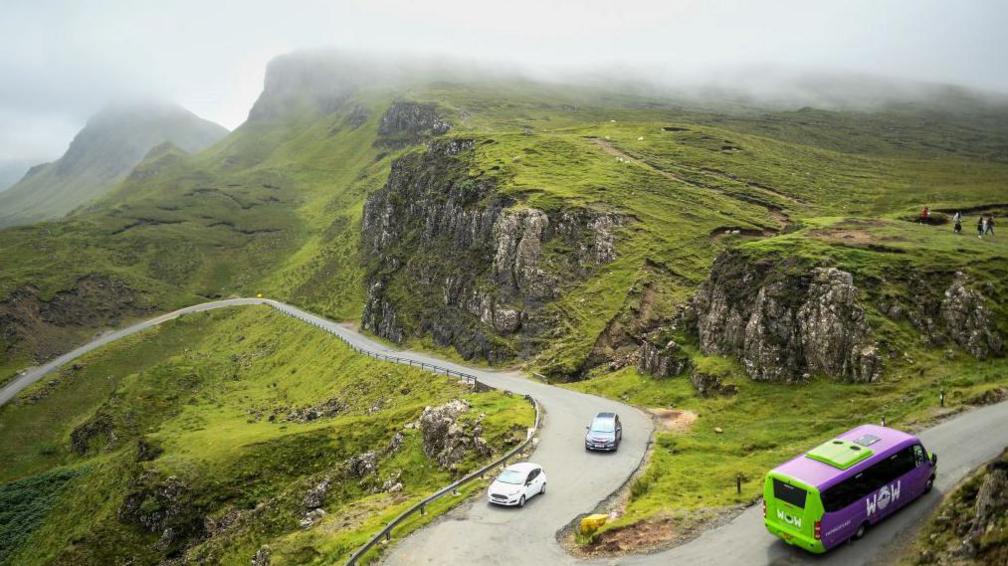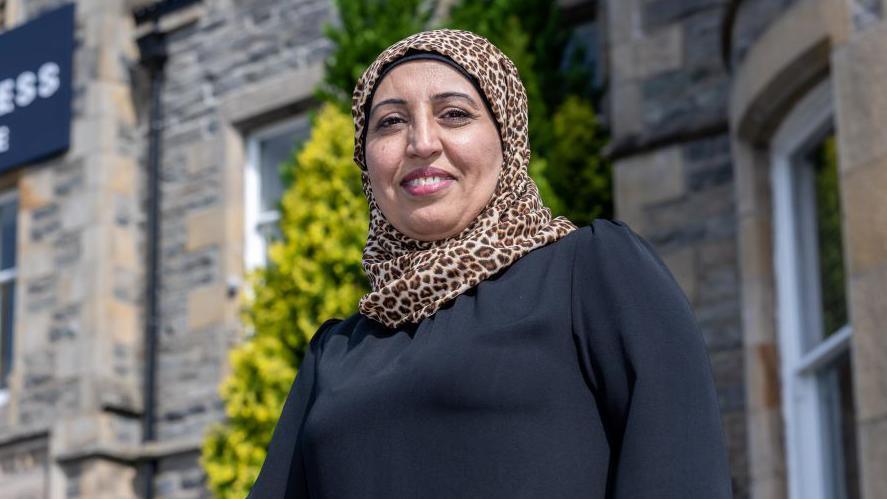Highland tourist tax could raise £10m a year

- Published
Highland Council has proposed a 5% tourist tax which it says could raise at least £10m a year for the local authority.
Councillors will be asked to approve a 12-week consultation on the plan at a meeting next week, external.
If the proposal goes ahead, there would be an 18-month implementation period before the visitor levy is introduced in September 2026.
MSPs approved a plan in May for councils to add a charge to overnight accommodation such as hotels, B&Bs and holiday lets.
How much extra could a holiday in the Highlands cost you at 5%?
£62.75Two adults and three children on a week-long £1,255 self-catering spring break in Aviemore
£9.95Parent and two children taking a £199 holiday on a caravan site in Embo
£22.65For a couple on a £453 three-night stay in a high-end Inverness hotel in February
8%The highest rate Highland Council has suggested for the levy
![In numbers:. How much extra could a holiday in the Highlands cost you at 5%? [ £62.75 Two adults and three children on a week-long £1,255 self-catering spring break in Aviemore ],[ £9.95 Parent and two children taking a £199 holiday on a caravan site in Embo ] [ £22.65 For a couple on a £453 three-night stay in a high-end Inverness hotel in February ],[ 8% The highest rate Highland Council has suggested for the levy ], Source: Source: Highland Council, Image: A mum lifting up and kissing her child with Highland scenery in the background.](https://ichef.bbci.co.uk/news/920/idt2/idt2/58f38de0-4e02-499f-905d-d96adafa4d6c/image/460)
Economy and infrastructure committee chairman Ken Gowans said the proposed consultation would ask people for their opinion on the scheme and the proposed levy rate of 5%.
He told BBC Scotland News the revenue could go towards improving infrastructure.
Highland has the longest road network in the UK with more than 4,200 miles (6,759km) of roads, in excess of 1,000 miles (1,609km) of footpaths and more than 2,200 bridges and culverts.
Mr Gowans said some of the money could go towards fixing potholes - a problem that has affected roads across the region.
He said: "The levy could raise £10m to £11m per year. It could bring us much more. It just depends.
"Tourism is one of our most important sectors and the levy could form an essential part of how we sustain, support and develop the services and infrastructure which the sector relies on."

Loch Ness Centre general manager Nagina Ishaq said the levy would need to be carefully managed
Frazer Coupland, chief executive of Lochaber Chamber of Commerce, said the idea of raising millions of pounds to invest in communities was "exciting".
But he said businesses were concerned about how the charge would be collected and how fairly the funds raised would be dispersed.
Mr Coupland told BBC Radio's Good Morning Scotland: "There is some anxiety around the consultation process.
"This is a massive geographic area and diverse amount of communities from city to rural and island."
Mr Coupland said the consultation would need to address whether people travelling from rural areas for hospital appointments would be charged the visitor levy for their overnight stays.
According to Highland Council's report, most patients travelling for medical treatment can apply to their NHS board for support in relation to accommodation and claim expenses.
Nagina Ishaq, general manager of the Loch Ness Centre in Drumnadrochit, said there were concerns the levy could impact on tourism businesses' operation costs.
She said: "The levy must be carefully managed with clear transparency to ensure funds are reinvested directly into tourism infrastructure.
"It could generate substantial funds for improving tourism infrastructure and sustainability, which is much needed given the increasing footfall, but we must not put our popularity in jeopardy."
Consultation on tourist tax plan for Scottish Highlands
- Published6 September 2024
Edinburgh backs introduction of new 'tourist tax'
- Published22 August 2024
The Highlands get more than six million visitors a year - including day trippers, overseas tourists and cruise passengers, according to Highland Council's figures.
Among its attractions are the North Coast 500 tourist route, which starts and finishes in Inverness, also the landscape of Skye and beaches along its 3,050 miles (4,905 km) of coastline.
The area also has parts of the Cairngorms National Park - the UK's largest national park - and in the north the new Unesco Flow Country World Heritage site.
Highland, Edinburgh and Aberdeen and other councils supported proposals for the tourist tax six years ago.

Under the proposals passed by MSPs earlier this:
The levy must be based on a percentage of the cost of an overnight stay in some types of accommodation, with the rate set by the local authority
Accommodation providers will be responsible for collecting the levy from overnight visitors
Money raised by the levy must be used to develop, support or sustain facilities and services used predominately by business and leisure visitors
Exemptions are given for certain groups, including people receiving disability benefits
In August 2019, Highland Council calculated it could generate as much as £10m a year from a levy, and reinvest the money into improving infrastructure such as roads, car parks and public toilets.
In 2019 the Highland tourist numbers reach a peak of seven million visitors.
The Covid pandemic hit tourism, but there have been recent signs of recovery and in 2022 there were more than six million visitors to the area.